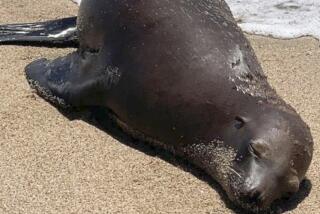Local Lifeguards Unconcerned About Ventura Shark Attack
- Share via
News of a weekend fatal shark attack off the Ventura County coast traveled slowly down to San Diego. And, when it got here, it caused hardly more than a ripple of concern.
In San Diego County, most lifeguard agencies were unaware of the Ventura County shark attack Monday afternoon--possibly the first such fatality in California in four years--and those who had heard the story said there was no cause for alarm.
“There have not been any attacks along our coastline for so many years, we would actually have to see one to put out an alert,” said Del Mar lifeguard Jim Lischer. “We’ve just never had a problem.”
“We have a million people in the water off Del Mar every year, and we have not had one shark bite in the 18 years I’ve been here,” Lischer said. San Diego city and county lifeguards also said they would take no steps to keep swimmers out of the water, since the threat is relatively distant.
A sailboat crew found the body of a young woman, believed to be a kayaker, about 6 miles off Channel Islands Harbor near Ventura on Saturday. The Ventura County coroner said Sunday that the woman appeared to be the victim of a “classic shark bite.” One expert said the attack appeared to be a “classic white shark scenario.”
Though great white sharks have been spotted off the San Diego coast--and occasionally captured by fishermen--there has never been a substantiated report of a great white attack off San Diego, according to Jim Stewart of the Scripps Institution of Oceanography.
Karlyn Pipes, a lifeguard at Silver Strand state beach for 10 years, said that problems with the many breeds of sharks that live near San Diego have been rare. “Of course there are sharks in the water here, especially near the Coronado Islands, but basically they don’t bother swimmers,” she said.
“Here, most shark attacks occur in 3 to 4 feet of water, the reason being that, when sea animals are ill and disoriented, they may end up on the beach,” Pipes said. “They might happen to bump into somebody and take a bite . . . but sharks don’t consider us to be a source of food.”
Pipes said shark attacks are more common near the San Francisco Bay Area, in part because of a strong commitment by Northern California communities to preserve the sea mammal population. “They have a real strong ‘Save the Seals’ movement up there, so the larger
population of seals draws the sharks,” she said. “To a shark, a surfer in a black wet suit might look like a food source,” Pipes said.
The area about 100 miles to either side of San Francisco is the “epicenter” of shark attacks off the California coast, according to Stewart, who has run a research diving program at Scripps for 30 years. Stewart said he has been diving for 48 years and was once bitten on the arm by a shark.
“We do get great whites through here, but there’s nothing really for them to feed on,” he said. “There are a few harbor seals around San Diego, but there are no sea lion rookeries. I think there’s nothing really to hold them here.”
There have been reports of swimmers, surfers and divers being bitten by some of the sharks more common to the area, such as hammerheads and blue sharks, Stewart said. But such incidents are rare and usually can be classified as accidents, he said, such as a 1959 incident in which a hammerhead bit a diver in the buttocks.
Diver Vern Fleet was spearfishing, and had a couple of fish tied to his belt when an 8-foot hammerhead shark bit him--it was apparently aiming for the fish, Stewart said. “Hammerheads can be pretty cantankerous and inquisitive, but they don’t normally bite people,” he said.
In the early ‘50s, a blue shark nipped the swim fin of a surfer off Imperial Beach, Stewart said. In 1984, a Phoenix man was bitten on the arm by an unknown fish--possibly a blue shark--while he was wading in the water off Mission Beach.
Other than those incidents, most reported shark attacks in San Diego have been relatively minor incidents that have grown to mythic proportions with time. A shark attack was reported off Black’s Beach in June, 1978--an anonymous caller said the victim had cuts on the arms and legs, but no victim was ever located. A sheriff’s helicopter did spot an 8-to-10-foot blue or white shark cruising the area, but when lifeguards interviewed people on the beach, no one had heard of an attack.
In July, 1957, it was reported that diver E. A. Murray was threatened by a 6-foot great white shark off La Jolla, but was able to fend off the creature with a blunt pole.
Many sightings of hammerhead sharks spooked swimmers off La Jolla, Pacific Beach and Mission Beach during the summer of 1983, but no shark-related injuries were reported.
Perhaps the most publicized account of a shark attack occurred in June, 1959, when a diver hunting for abalone in La Jolla Cove was reportedly devoured by a tiger shark. No trace of Rober Pamperin was ever found, and he was declared legally dead.
But Stewart, who was there when Pamperin disappeared, said he doubted the diver’s disappearance could be attributed to a shark.
“I was one of the first people in the water when that attack happened,” Stewart said. “There’s not a shark alive that can swim off with that large a man, yet not a piece of him was found.”
More to Read
Sign up for Essential California
The most important California stories and recommendations in your inbox every morning.
You may occasionally receive promotional content from the Los Angeles Times.










